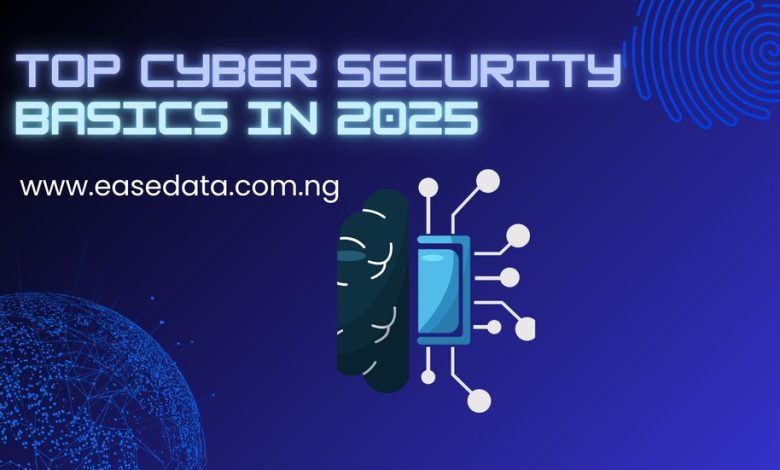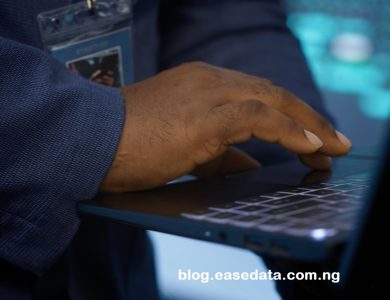Top Cybersecurity Basics You Need to Know in 2025 to Protect Your Data
Key Tips to Secure Your Digital Life in 2025

Top Cybersecurity Basics You Need to Know in 2025 to Protect Your Data. Cybersecurity is a critical aspect of our digital lives. With the ever-evolving landscape of cyber threats, understanding cybersecurity basics is essential for individuals and businesses. Many people have been scammed in one way or the other.
In this guide, we will explore the top cybersecurity practices you must adopt in 2025 to safeguard your data and systems effectively.
Top Cybersecurity Basics You Need to Know in 2025
What is Cybersecurity?
Cybersecurity refers to the protection of computer systems, networks, and data from digital attacks, unauthorized access, and damage. It encompasses various practices, technologies, and processes designed to ensure the confidentiality, integrity, and availability of information.
Why is Cybersecurity Important in 2025?
- Increasing Cyber Threats: The rise of sophisticated malware, ransomware, and phishing scams has made cybersecurity more crucial than ever.
- Digital Transformation: As more businesses embrace digital tools, protecting sensitive data becomes a top priority.
- Regulatory Compliance: Many industries require adherence to cybersecurity standards to avoid legal penalties.
Types of Cybersecurity Threats to Watch Out For in 2025
1. Malware Attacks
Did you know that Malware, including viruses, worms, and ransomware, is designed to damage or disrupt systems? It often infiltrates devices through malicious downloads or email attachments. This the more reason you must avoid downloading certain types of links.
2. Phishing Scams
Phishing attacks involve fraudulent emails or messages that trick users into revealing sensitive information, such as passwords or credit card details.
3. Distributed Denial of Service (DDoS) Attacks
These attacks flood a network or server with traffic, causing it to crash and become inaccessible to legitimate users.
4. Insider Threats
Employees or contractors with access to sensitive systems can intentionally or unintentionally compromise security.
Essential Cybersecurity Practices for 2025
1. Use Strong and Unique Passwords
Create passwords that combine uppercase and lowercase letters, numbers, and special characters. Avoid using the same password across multiple accounts.
2. Enable Multi-Factor Authentication (MFA)
MFA adds an extra layer of security by requiring a second form of verification, such as a code sent to your mobile device or androids.
3. Regularly Update Software and Systems
Outdated software can have vulnerabilities that cybercriminals exploit. Regular updates ensure you have the latest security patches.
4. Secure Your Network
- Use a reliable firewall to block unauthorized access.
- Set up a Virtual Private Network (VPN) when using public Wi-Fi.
Types of Cybersecurity Threats to Watch Out For
1. Malware Attacks
Malware, including viruses, worms, and ransomware, is designed to damage or disrupt systems. It often infiltrates devices through malicious downloads or email attachments.
2. Phishing Scams
Phishing attacks involve fraudulent emails or messages that trick users into revealing sensitive information, such as passwords or credit card details.
3. Distributed Denial of Service (DDoS) Attacks
These attacks flood a network or server with traffic, causing it to crash and become inaccessible to legitimate users.
4. Insider Threats
Employees or contractors with access to sensitive systems can intentionally or unintentionally compromise security.
Essential Cybersecurity Practices for 2025
1. Use Strong and Unique Passwords
Create passwords that combine uppercase and lowercase letters, numbers, and special characters. Avoid using the same password across multiple accounts.
2. Enable Multi-Factor Authentication (MFA)
MFA adds an extra layer of security by requiring a second form of verification, such as a code sent to your mobile device.
3. Regularly Update Software and Systems
Outdated software can have vulnerabilities that cybercriminals exploit. Regular updates ensure you have the latest security patches.
4. Secure Your Network
- Use a reliable firewall to block unauthorized access.
- Set up a Virtual Private Network (VPN) when using public Wi-Fi.
5. Educate Yourself and Your Team
Train yourself and employees to recognize phishing scams and follow safe online practices. Awareness is a powerful defense against cyber threats.
Key Tools and Technologies to Enhance Cybersecurity
1. Antivirus Software
Antivirus programs detect and remove malicious software from your devices. Ensure it’s updated regularly to combat the latest threats. For instance, businesses like Sony avoided significant damage during a malware attack in 2014 by implementing advanced antivirus tools.
2. Data Encryption
Encryption converts data into unreadable code, making it inaccessible to unauthorized users. A real-life example is WhatsApp, which uses end-to-end encryption to ensure that only the sender and recipient can access messages, protecting users from data breaches.
3. Intrusion Detection Systems (IDS)
IDS monitor network traffic for suspicious activities and alert you to potential threats. In 2020, a major financial institution used IDS to identify and mitigate a ransomware attack, saving millions of dollars in potential losses.
4. Cybersecurity Frameworks
Adopt frameworks like NIST Cybersecurity Framework or ISO 27001 to establish and maintain robust security practices. For example, healthcare providers often use these frameworks to comply with regulations like HIPAA, ensuring patient data protection.
5. Backup and Recovery Tools
Regular backups ensure that critical data can be restored quickly in case of a cyberattack. Organizations like Garmin, which faced a ransomware attack in 2020, minimized downtime and data loss by relying on robust backup systems.
Emerging Cybersecurity Trends in 2025
1. AI-Powered Security Solutions
Artificial intelligence is being used to predict, detect, and respond to cyber threats more effectively. AI-driven tools helped Microsoft identify unusual login patterns during a widespread phishing campaign in 2021.
2. Zero Trust Security Model
This approach assumes no user or device is trustworthy by default, requiring continuous verification. Companies like Google have adopted Zero Trust models to protect their internal systems, significantly reducing the risk of insider threats.
3. Quantum-Safe Encryption
With advancements in quantum computing, traditional encryption methods are being replaced with quantum-safe algorithms. For instance, governments and financial institutions are already investing in quantum-resistant technologies to safeguard sensitive information against future quantum threats.
To Learn about the NIST Cybersecurity Framework and guidelines for robust security practices, visit here.
In 2025, try staying vigilant. Cybersecurity is not a one-time effort but a continuous process. By adopting the practices and tools discussed in this guide, you can significantly reduce your risk of falling victim to cyber threats. Protecting your digital assets is not just a necessity; it’s a responsibility.
Follow us at easedata.com.ng for more relevant security tips.

